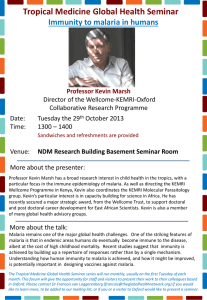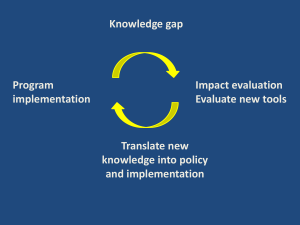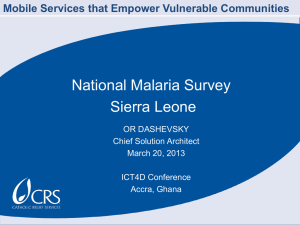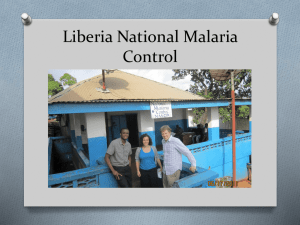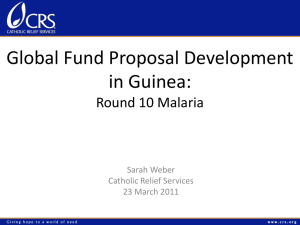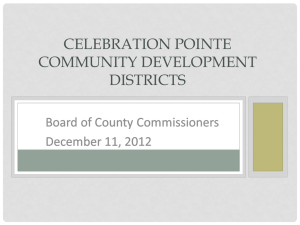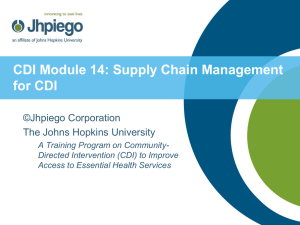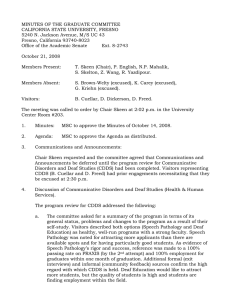Sample CDD Module on Community Case
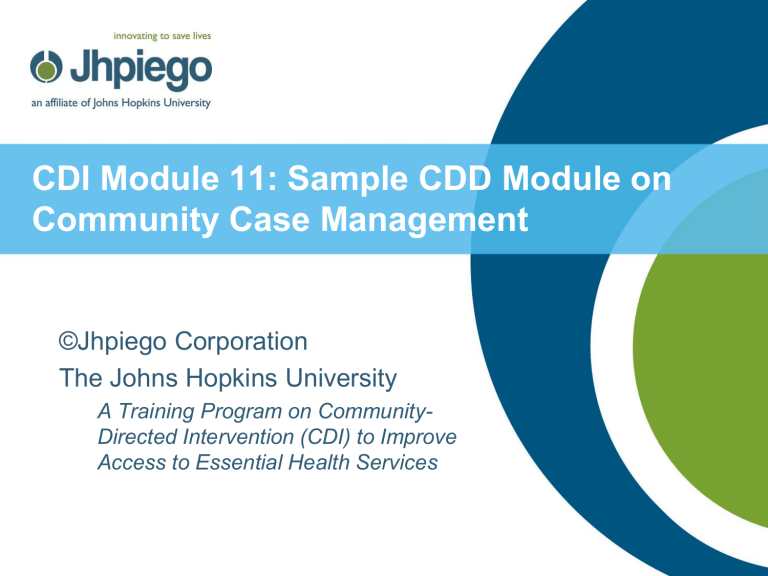
CDI Module 11: Sample CDD Module on
Community Case Management
©Jhpiego Corporation
The Johns Hopkins University
A Training Program on Community-
Directed Intervention (CDI) to Improve
Access to Essential Health Services
Module 11 Objectives
By the end of this simulated, community-directed distributor (CDD) training module, learners will:
List the basic local resources needed to carry out CDD training
Describe the basic malaria content that is appropriate for community-level volunteers
Outline training methods that are appropriate for community volunteers
Explain how community volunteer training can be evaluated
2
Simulated Module for CDDs
This module is a bit different from the others
We will simulate the steps in presenting a training session on malaria case management for CDDs
We ask each of you to pretend you are a CDD from your home village
3
Resources Needed for Local CDD Training on Malaria Case Management
A community-directed intervention (CDI) focal person from the health center to serve as a facilitator
Samples of malaria medicines
Flip chart and marker and/or chalk and chalkboard
Treatment recording forms
Job aids
Information, education and communication (IEC) materials (e.g., counseling card)
Quiet, well-ventilated room near the community
Time: Two hours
4
Overview of Session on Community Case
Management for CDDs
During this CDD training session, we will cover the following:
Module Objectives
Recognizing Malaria
Treating Malaria
Counseling for Adherence
Recording Services
Monitoring, Follow-up and Referral
Evaluation of Module
5
Objectives for Training Session on Malaria Case Management for CDDs
By the end of the session, the CDDs will:
List clinical signs and symptoms for recognizing malaria
Demonstrate how to treat malaria with appropriate medicines and doses
Role play counseling on how to encourage clients to take their medicines correctly
Record the services provided in the register
Explain how, when and why to monitor, follow up and refer clients
6
Recognizing Malaria
Ask CDDs: “In your village …”
How do we know if someone has malaria?
(Write answers on chart/board )
What are the most common, important signs?
How do we know if someone has fever?
( Demonstration and return demonstration)
What other diseases come with fever?
(Write answers on chart/board )
How do we tell which of these diseases is really malaria?
7
How Do We Check for Fever?
8
Rapid Diagnostic Tests (RDTs)
Volunteers in Rwanda and Mozambique use RDTs
What about in your country?
9
Treating Malaria
Ask CDDs :
What medicines are used for treating malaria in this community?
(Write answers on chart/board )
Which are most effective? Why?
What medicines for malaria are recommended by the Ministry of Health?
( Show samples of artemisinin-based combination therapies [ACTs] in age-specific packets)
(Ask CDDs to discuss what they see and what they know about these; address concerns)
10
Coartem Comes in Different Age Doses
Pass around samples
Ask learners what they observe
11
Review Doses by Age
Ask learners what they see on the card
Make sure they:
Note the picture at the top to determine dosage by age group
Identify the six clusterings of tablets and explain what these mean
12
Treating Dosage for Malaria
Cover the following topics with CDDs :
Review dosages by age
Talk about the importance of taking all of the drug dosage, as directed
Discuss what to do about people who have fever but do not have malaria
Ask a volunteer to tell a story about what happens when a
CDD:
Gives correct treatment
Gives incorrect treatment
Ask one of the learners to tell a story about what happens when:
A client takes a drug correctly
A client does not take a drug correctly
13
Treatment Scenarios
Situation
Yemi is two years old, has fever and is coughing
Ibrahim is five years old, has fever, chills and loss of appetite
Uwem is three years old, has fever, running nose and sore throat
Uche is four years old, has body ache and fever
What would you do?
Work in groups/pairs and report back
14
Counseling for Treatment
Steps in Counseling
1.
2.
3.
4.
5.
6.
Show the patient/caregiver the appropriate ACT packet
Ask the client what she or he sees
Point out the days and doses
Explain the importance of taking all of the medicine over the three days
Ask clients if they will have any problem taking the drugs correctly , and explain what to do
Ask the client to repeat all instructions/steps
15
Sample Job Aid
Provide simple job aids that are actually used in your own country
16
Counseling: Lead the Following Activities
The facilitator should:
Conduct a role play about recognizing, treating and counseling —learners give feedback; repeat role play
Ask learners to make up a song that will help clients remember how to take their drugs correctly and fully
17
Record the Treatment Provided
The facilitator should:
Show samples of the recording form
Discuss the different sections
Practice recording different scenarios (e.g., different ages)
CDDs should:
Give each other feedback on quality of recording
18
Recording Treatment
19
Monitoring and Following Up after Treatment
The facilitator should:
Remind learners that people need to take ACT twice a day for three days
Explain what happens if a person does not take all of the medicine or takes it incorrectly
Lead a group discussion on how to do monitoring and follow-up to ensure that people take their medicines fully and correctly
20
Follow-Up —Referral
The facilitator should:
Outline when a patient needs to be referred to the health center
Hold a discussion on how to ensure that people will transport the referred patient to the health center
Conduct another role play using ideas generated on how to ensure that referral happens
21
Evaluation Q & A for (Simulated) CDDs
How do we know a person really has malaria?
What are the correct drugs for malaria?
What is the dosage for these drugs?
What happens if people do not take the drugs fully and correctly?
What are the steps to counsel a client to take the malaria medicine?
How do we record the treatment provided?
What should we do to follow up clients to ensure that they completed the correct treatment?
22
Summary
Now return to your role as regular workshop learners and discuss the following:
Were we able to make information easy to understand for typical village CDDs?
What methods are effective in training CDDs and how do these differ from formal classroom instruction?
How can we ensure participatory learning for CDDs?
What are the most effective ways to evaluate what
CDDs learned in training?
23


